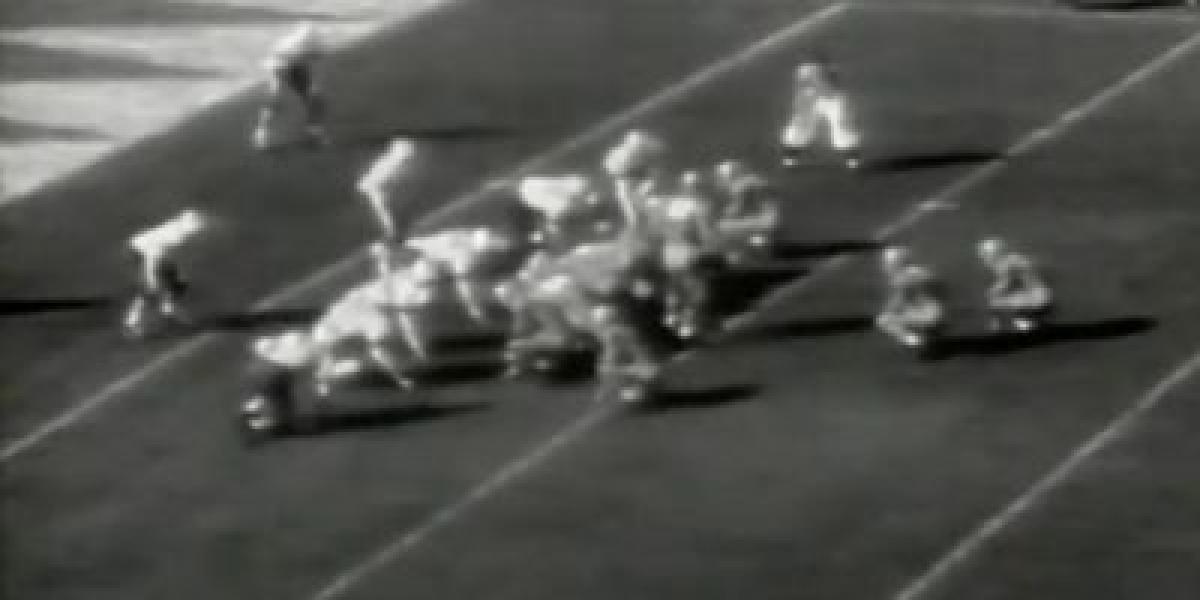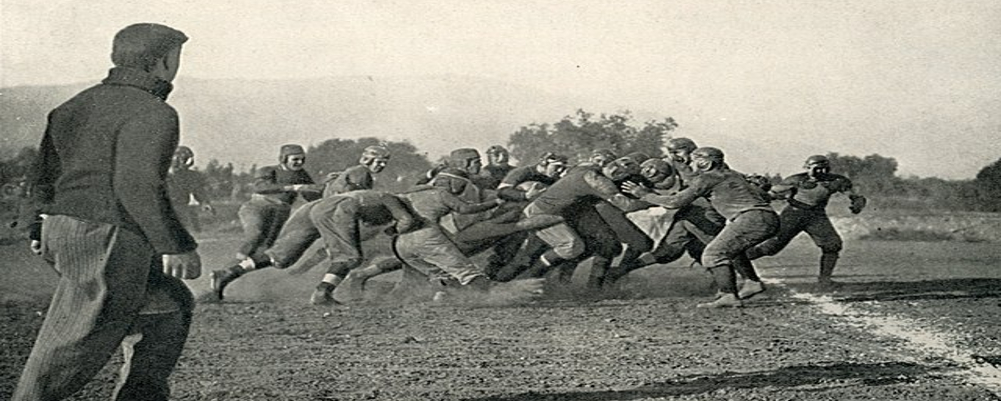In this episode, we talk with Football Archaeology founder Timothy P. Brown and a recent Tidbit he wrote that examines an extremely odd offensive formation used once by the University of Tennessee long ago.
The subject originates from Tim's Tidbit post titled:The Sidesaddle Quarterback and Tennessee Formation.
Transcribed Conversation of the Side-Saddle QB with Timothy Brown
Hello, my football friends, this is Darin Hayes of PigskinDispatch.com. Welcome once again to the Pig Pen and welcome to another edition of Tuesdays where we go and visit Timothy P. Brown of FootballArcheology.com, and he shares one of his most recent tidbits on some great football history with some great insight. And we really enjoy this. And Tim, tonight you have a great subject to talk to us about and welcome back, by the way.
You wrote a tidbit about side saddle quarterback formation, and we're anxious to hear about it and what you have to say about its history. Yeah, so this is one of those where, and thank you for your gracious welcome, by the way, that this sort of got thrown in there. Sorry about that.
Yeah, so, you know, this is one where, you know, I enjoy it, and I think, you know, people who are into football enjoy some oddities that came along the way. Right. And, you know, the game did not show up the way it's packaged today.
So, there are some things that were done by some of the top coaches that just seem a bit odd. So this one, the side saddle quarterback, you know, in order to kind of understand it, I got to go back another, you know, maybe even 60 years because side saddle was kind of 30s and 40s. And Tennessee, especially, is used a lot.
But, you know, in the so if you think about even rugby today. The guy that we might consider the quarterback is the guy who gets the ball. You know, they're having the scrum, and they're using their feet to kick the ball back to that person.
Then he picks it up and tosses it to somebody else. Well, when football began, they did exactly the same thing because they were playing rugby. And then even as they started, you know, going with the rule of possession and downs and all of that, they still were doing fundamentally the same thing.
The center snapped the ball. With his foot and, you know, the ball was laying on its side. He put his foot on top of it or put his foot in front of it, and he healed it back or rolled it, you know, put it either way.
He rolled the thing back. And so the ball was coming back unpredictably. And so the quarterback, just like the guy in rugby, was kind of squatting behind a foot or two behind the center.
And he picked the ball up and tossed it to somebody else to run with it. So then, in football, you know, in the late 1890s, they started snapping with their hands. Initially, there was a great photo of Henry Lewis, who was an All-American center at Harvard.
You see him snapping with his hand, but he's got the ball on its side. So when they first started snapping the hand, they were still doing just like they did with the feet. They rolled it on its side back to the quarterback.
So the quarterback stayed in more or less the same position as that rugby guy and, you know, grabbed the ball and then tossed it. So then a little bit later on, then they started what we really now think of as snapping, where they were lifting the ball up and tossing it, either lifting it and putting it between their legs where the quarterback had his hands, not up on the butt, but down low. And he'd grab it, or they just roll it back, or they toss it back to him.
So a lot of times, that quarterback sometimes is directly behind the center and other times is off to the side, so kind of between the guard center gap. And, you know, and I'm not sure exactly what the rationale was for that back in the day, but that all pretty much mostly went away. You know, in the early 19 teens, when the Notre Dame box was getting big, there was a rule change regarding who could run with the ball.
The first guy receiving the center, the snap from the center, could now run with the ball. And so they started snapping back to. The fullback or halfback in the backfield.
And so the whole single wing offense and, you know, the Carlisle formation and all that kind of stuff was coming into play. So, a lot of times at that point, the quarterback never even touched the ball. But a lot of times, you stay in that same position.
Sometimes you move over a position or two. But there were times that he'd still he'd still get the ball. You know, it's more of a fake, you know, or a change up for them.
But then in, in the 30s, Tennessee developed the side saddle QB formation. And it got it, you know, it got him to the Rose Bowl. So, I mean, they were they were a heck of a team, you know, back then.
They were, you know, there were a lot of good things going on. But the side saddle quarterback, you know, like this earlier guy, he'd align in kind of the guard center gap. And he would, but he'd be perpendicular to the line of scrimmage.
Right. And he was fake. He was in the guard center gap on the strong side, but he was facing the weak side.
And then from there, he could he could get the snap, though, that he was more of a faker and blocker than, you know, a runner. But he could get the snap. Most of these still snapped it back to the to the deep backs.
And, you know, it was just, you know, I think they had the belief that this could be something that aligned him that way, confusing the offense or, I'm sorry, confusing the defense. And it allowed him to do, you know, spin moves and reverse out and lead, you know, lead blocking to the weak side more effectively because they used to run, you know, dives to the weak side. He'd head over to the weak side and, you know, smash up in there.
So it's just one of those goofy things that it's like, you know, I don't know how they figured out that they thought, you know, why exactly why they thought this was better than other approaches, but it worked. And so then there were, you know, after that, guys from Tennessee, you know, guys who played there like Bowden Wyatt. He ended up being the coach at Wyoming after the war.
Or, yeah, in forty-seven. He was in Arkansas, and then he ended up being the coach in Tennessee. But they, you know, he continued using it, though he converted to the side saddle running a tee rather than a single wing.
And there were other guys, you know, place another guy used it at Wyoming. It was used at Amherst, Brown, and BYU, BYU, even in the early 60s. And then the one that, you know, maybe surprises most people is that of the guy named Bede. I believe his last name is Bede.
I'm not sure if it's Bede or Bede, but Dick Bede from Youngstown State. He's the guy who invented the penalty flag. But he ran the side saddle in the late 60s and early 70s.
One of his last quarterbacks was Ron Jaworski. So, you know, Jaworski, I mean, it's new enough that if you're old enough to remember Ron Jaworski as a player, then this side saddle thing is a little bit closer than you might expect. You know, it's not that far back in the game's history.
So it's just one of those little oddities. It's just kind of fun to think about and how they ended up coming up with this thing. Yeah, I mean, it's definitely interesting.
It's very unique. And I think these coaches, you know, they're what makes football so interesting. It's all these games within a game and a strategy.
And how can you put the defense under duress to gain an advantage in changing formation, having something they're not used to seeing? I'm sure that gains an advantage real quick if a defense isn't ready for it. So, somebody like Bill Belichick or somebody else will probably bring this out. One of these upcoming seasons, and we'll all sit down and say, hey, Tim talked about that back last year.
Well, yeah, Belichick's a big old time football scholar. So he's he's I'm sure he's very familiar with with this thing. But yeah, if anybody would pull it, pull it out, it'd probably be Belichick.
Well, look at the NFL basically brought the single wing back. What, 10 years ago when they they call it the wildcat. But they're running single single-wing principles.
Yeah. Yeah. I mean, that's what a lot of that stuff is.
Even, you know, some of the things like the counter tray. And, you know, I mean, that goes back a little bit further. But that's just wing T-type stuff as far as I'm concerned, you know.
And so, yeah, it's what's old and new again. And, you know, it's sometimes what we think of as new, sometimes just somebody under comparable. You know, situations came up with the same thing all on their own.
Right. And other times they were just watching an old film or came across some concept and, you know, they borrowed from the old guys. But either way, hey, if it reinvigorates the game and and brings in something what what looks to be new.
You know, that's great. Yeah, most definitely. Well, Tim, speaking of something new, you have something new that comes out each and every day in your tidbits, something new to us that's actually old and a game of football.
And we really appreciate the wide array of things that you present to us each week. Now, there's people out there that are always wondering how they can be enjoying it on these tidbits each and every day. And if you could share that secret with them, they'd be much obliged.
Yeah. So it's no secret at all. If you're if you're interested in it and you're reading the articles every day, just go to Football Archeology, Football Archeology dot com.
Subscribe. It's free. So and you'll just get an email every day with the you know, with the information in your inbox.
I mean, you can still go to the site and read, read the past, read the archives, etc. The other alternative is, you know, I post each tidbit on Twitter, so you can follow me on Twitter at Football Archeology. And that's it.
But hopefully either way, you get it and you read it and you have fun with it. Yeah. And the beauty of it is football history is evergreen.
So whether you look at it tonight or you look at it 10 years from now, it's still going to be the same as this history. So still be refreshing. So, Tim, I really appreciate you sharing your time and your knowledge with us and this great football history.
And we will talk to you again next Tuesday. Very good. Thank you, Darin.
Transcribed by TurboScribe.ai.




